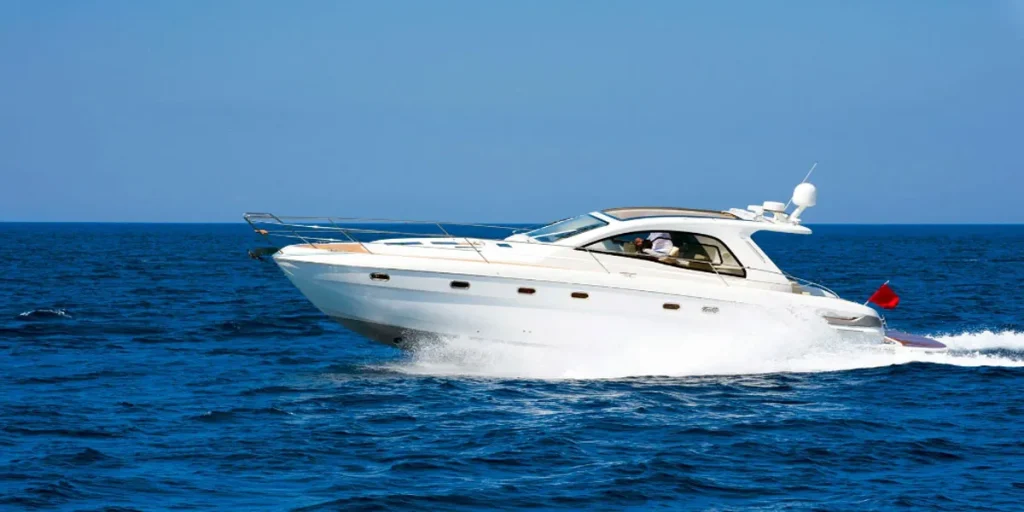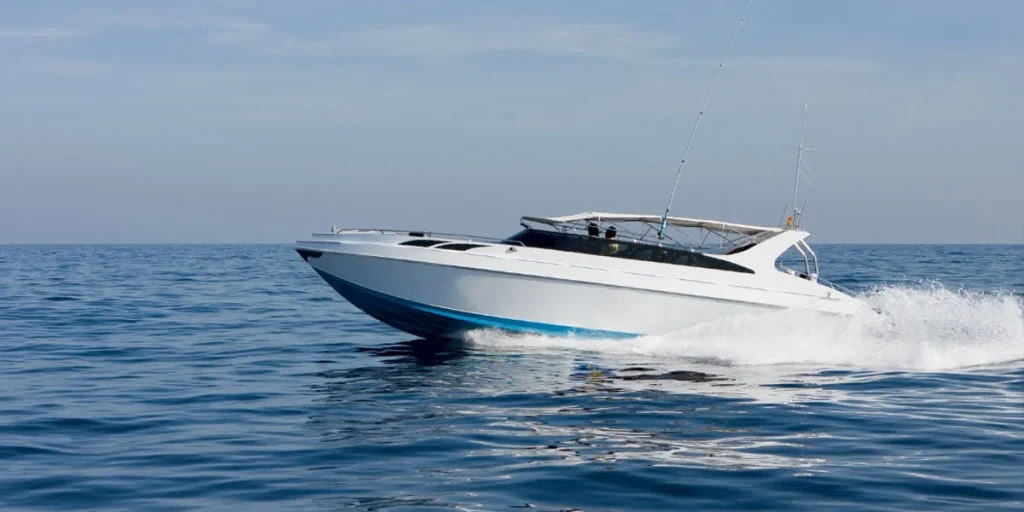A typical speed boat can weigh anywhere from 1,500 to 8,000 pounds. The weight varies depending on size, materials, and design.
Navigating the vibrant world of speed boats brings you face-to-face with a thrilling blend of performance and luxury.
These swift marine craft are tailored for enthusiasts who seek adrenaline-packed experiences on the waves.
The variety of speed boats available is immense, with models ranging from sleek, lightweight versions designed for pure speed, to more robust, feature-packed boats that blend velocity with comfort.
Made from advanced composites or sturdy aluminum, the weight of these boats is meticulously balanced to ensure high-speed stability and optimal performance.
As a prospective buyer or an aficionado, understanding the weight implications is key to assessing trailering needs, fuel economy, and handling characteristics.
Whether you’re a seasoned mariner or new to nautical adventures, the fascination with these powerful vessels is universal, as they continue to captivate and excite with their blend of speed and style.
The Ins And Outs Of Speed Boat Weight

Imagine the splash as the hull cuts through waves. Feeling the spray on your face, you glance back at the wake. This power and grace come from the speed boat’s design, including its weight.
Let’s dive into the world of speed boats and see how every pound plays a pivotal role in their performance.
Speed Boat Basics
Speed boats are thrilling. They zip across the water. They range in size, shape, and weight. These factors define their use.
Smaller speed boats can weigh as light as 1,500 pounds. Large ones can tip the scales at over 8,000 pounds. Let’s break down the details:
| Speed Boat Type | Average Weight Range |
|---|---|
| Personal Watercraft | 850 – 1,200 lbs |
| Small Runabout | 1,500 – 2,500 lbs |
| Mid-Size Speed Boat | 2,500 – 5,000 lbs |
| Large Speed Boat | 5,000 – 8,000 lbs+ |
Significance Of Weight In Nautical Design
The weight of a speed boat matters a lot. It affects stability, speed, and safety. Light boats are fast and easy to tow. Heavy boats ride smoother in rough waters.
Designers think about weight when they build boats. They choose materials and features carefully. Here are some points on why weight is crucial:
- Fuel efficiency: Lighter boats often use less gas.
- Speed: Weight can limit or boost how fast the boat goes.
- Handling: Heavier boats might be harder to steer but offer more control.
Manufacturers disclose a boat’s dry weight. But, remember to count passengers, gear, and fuel. These add to the total weight and influence performance.
Types And Their Typical Weights

Welcome to the world of speed boats, where sleek design meets thrilling speeds.
Understanding the weight of different types of speed boats is crucial for enthusiasts and potential buyers alike.
Let’s dive into the diverse categories and explore the typical weights you might encounter.
The Weight Range Spectrum
Speed boats come in a variety of shapes and sizes, each designed for specific needs and water conditions. Here are some common types:
- Skiffs: Light and versatile, usually weighing between 300-900 pounds.
- Jet Boats: Known for powerful propulsion, they tip the scales at about 2,500-3,500 pounds.
- Bass Boats: Ideal for fishing, with an average weight of 1,500-2,500 pounds.
- Cigarette Boats: Built for speed, these can weigh 5,000 pounds or more.
- Racing Boats: Specially designed for high performance and can range from 3,000 to over 9,000 pounds.
How Construction Influences Weight?
The weight of a speed boat largely depends on its construction materials. Below are common materials used:
| Material | Characteristics | Weight Impact |
|---|---|---|
| Fiberglass | Durable and sleek | Medium to heavy |
| Aluminum | Lightweight and sturdy | Light to medium |
| Wood | Traditional, classic appeal | Varies with type |
| Composite Materials | Advanced, high-tech | Light to medium |
Fiberglass is common in recreational boats, adding to the weight for stability.
Aluminum offers a lighter option, often used in fishing boats. Wooden boats vary in weight, influenced by construction techniques.
Composite materials, which mix different substances, provide a balanced weight while optimizing for speed.
Impact Of Size And Features On Boat Weight
Understanding how much a speed boat weighs is crucial. The weight affects handling, speed, and transportation. Size and features play a huge role in a boat’s weight.
Everyone knows big boats are heavy, but what about those speed boat features? They add weight too.
Understanding The Proportional Influence
Length and beam determine a boat’s basic size. Longer boats typically weigh more, as do wider ones.
This makes sense because more materials go into building them. But it’s not just about size. The boat’s design matters too.
Consider two key dimensions:
- Length: From front to back, longer means heavier.
- Beam: This is the boat’s width. Wider beams add stability and weight.
These dimensions influence a boat’s weight in a big way.
Weighing The Add-ons
Speed boats come with cool features. Think of fridges or advanced navigation systems. Each extra adds pounds. A boat’s base weight is just the beginning.
Some common add-ons include:
| Add-on | Estimated Weight Increase |
|---|---|
| Air Conditioning | 100-200 lbs |
| Wakeboard Towers | 50-150 lbs |
| Sound Systems | 30-100 lbs |
Remember, all these extras mean a heavier boat.
How Weight Affects Compliance?
Understanding the weight of a speed boat is crucial for compliance with maritime regulations.
Weight impacts safety protocols, speed limits, and boat performance. Knowing these factors ensures legal and efficient voyages.
Weight Limits And Safety Standards
Maritime laws have specific weight limits based on boat size and type. Exceeding these limits can lead to penalties. Compliance with safety standards is non-negotiable.
- Boat classification determines weight limits.
- Regular inspections ensure compliance.
- Overloading a boat risks fines and accidents.
The Role Of Weight In Speed And Efficiency
Weight affects a boat’s speed and fuel efficiency. Proper balance ensures peak performance. Heavier boats require more fuel, which increases operational costs.
| Boat Type | Average Weight | Impact on Speed |
|---|---|---|
| Small Speed Boat | 2,500 lbs | Higher speed, less fuel |
| Medium Speed Boat | 5,000 lbs | Moderate speed, balanced fuel |
| Large Speed Boat | 8,000 lbs | Lower speed, more fuel |
Lighter boats are nimbler, allowing for quicker maneuvers. Heavier boats warrant more power, affecting efficiency.
Considerations For The Prospective Owner
Embarking on the journey to own a speed boat is thrilling. It’s a blend of freedom, power, and the embrace of the open water.
Yet, before you dive into this exciting venture, weigh the considerations of both purchase and upkeep. A speed boat’s weight affects many aspects, from trailering to fuel economy.
Understand the ins and outs to ensure your boating bliss remains undisturbed.
Decoding The Sales Listing: What To Look For
Scan each sales listing carefully. Key details influence your buying decision.
- Boat Type: Match the model to your intended use.
- Weight Details: Consider if you can transport it easily.
- Capacity: Check the maximum weight it can hold.
- Engine Power: More power can mean more weight.
- Construction: Quality materials can add to weight.
Keeping Your Speed Boat Sea-ready
Regular maintenance keeps your speed boat in top shape. Attention to weight is crucial. This impacts performance and safety.
Care for every part:
- Clean regularly: Remove debris and marine growth.
- Check weight limits: Adhere to manufacturer guidelines.
- Inspect your trailer: It must support your boat’s weight.
- Store properly: Protect from elements during off-season.
Record maintenance tasks to stay on top of the boat’s condition. A well-maintained boat preserves value and ensures reliability. Know your boat’s weight, and adjust maintenance accordingly.
FAQ About the Weight of a Speed Boat
What Is The Average Weight Of A Speed Boat?
The average weight of a speed boat can range from 1,500 to 4,500 pounds.
Factors such as size, materials used, and additional features can lead to variations in weight.
How Do Speed Boat Weights Impact Performance?
Heavier speed boats tend to have more stability but may be slower.
Lighter boats are typically faster and more responsive but can be less stable in rough water.
Balance and design play critical roles in performance.
What Factors Contribute To A Speed Boat’s Weight?
Key factors influencing a speed boat’s weight include its hull material, length, engine size, and onboard equipment.
Additional customizations can also increase the overall weight.
Does Size Correlate With Speed Boat Weight?
Generally, larger speed boats weigh more due to increased materials and more substantial construction needs.
However, advanced materials and design can offset some weight increases.
Conclusion
Understanding the weight of speed boats is crucial for prospective buyers and enthusiasts alike. Different models vary significantly, from lightweight racers to heavier leisure crafts.
Always consider the load you’ll carry, as it impacts overall performance and safety. Remember, the right information ensures a smooth sailing experience.
Choose wisely and enjoy the thrills of speed boating!
Resources:
https://www.maine.gov/ifw/fishing-boating/boating/index.html
https://www.commerce.gov/news/blog/2022/08/know-you-go-boating-safety-tips-noaa
